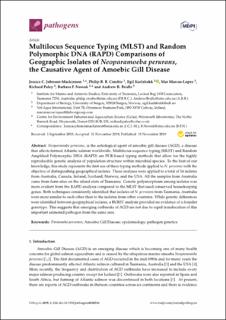| dc.contributor.author | Johnson-Mackinnon, Jessica C. | |
| dc.contributor.author | Crosbie, Philip B.B. | |
| dc.contributor.author | Karlsbakk, Egil | |
| dc.contributor.author | Marcos-Lopez, Mar | |
| dc.contributor.author | Paley, Richard | |
| dc.contributor.author | Nowak, Barbara F. | |
| dc.contributor.author | Bridle, Andrew R. | |
| dc.date.accessioned | 2021-02-10T14:05:10Z | |
| dc.date.available | 2021-02-10T14:05:10Z | |
| dc.date.created | 2020-03-03T17:12:53Z | |
| dc.date.issued | 2019 | |
| dc.Published | Pathogens. 2019, 8 (4), 244. | en_US |
| dc.identifier.issn | 2076-0817 | |
| dc.identifier.uri | https://hdl.handle.net/11250/2727245 | |
| dc.description.abstract | Neoparamoba perurans, is the aetiological agent of amoebic gill disease (AGD), a disease that affects farmed Atlantic salmon worldwide. Multilocus sequence typing (MLST) and Random Amplified Polymorphic DNA (RAPD) are PCR-based typing methods that allow for the highly reproducible genetic analysis of population structure within microbial species. To the best of our knowledge, this study represents the first use of these typing methods applied to N. perurans with the objective of distinguishing geographical isolates. These analyses were applied to a total of 16 isolates from Australia, Canada, Ireland, Scotland, Norway, and the USA. All the samples from Australia came from farm sites on the island state of Tasmania. Genetic polymorphism among isolates was more evident from the RAPD analysis compared to the MLST that used conserved housekeeping genes. Both techniques consistently identified that isolates of N. perurans from Tasmania, Australia were more similar to each other than to the isolates from other countries. While genetic differences were identified between geographical isolates, a BURST analysis provided no evidence of a founder genotype. This suggests that emerging outbreaks of AGD are not due to rapid translocation of this important salmonid pathogen from the same area. | en_US |
| dc.language.iso | eng | en_US |
| dc.publisher | MDPI | en_US |
| dc.rights | Navngivelse 4.0 Internasjonal | * |
| dc.rights.uri | http://creativecommons.org/licenses/by/4.0/deed.no | * |
| dc.title | Multilocus Sequence Typing (MLST) and Random Polymorphic DNA (RAPD) Comparisons of Geographic Isolates of Neoparamoeba perurans, the Causative Agent of Amoebic Gill Disease | en_US |
| dc.type | Journal article | en_US |
| dc.type | Peer reviewed | en_US |
| dc.description.version | publishedVersion | en_US |
| dc.rights.holder | Copyright 2019 by the authors. | en_US |
| cristin.ispublished | true | |
| cristin.fulltext | original | |
| cristin.qualitycode | 1 | |
| dc.identifier.doi | 10.3390/pathogens8040244 | |
| dc.identifier.cristin | 1799432 | |
| dc.source.journal | Pathogens | en_US |
| dc.source.40 | 8 | en_US |
| dc.source.14 | 4: 244 | en_US |

